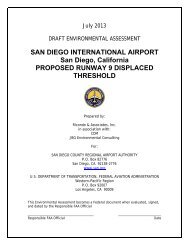Brown Field Municipal Airport Land Use Compatibility Plan
Brown Field Municipal Airport Land Use Compatibility Plan
Brown Field Municipal Airport Land Use Compatibility Plan
- No tags were found...
Create successful ePaper yourself
Turn your PDF publications into a flip-book with our unique Google optimized e-Paper software.
APPENDIX FSAMPLE IMPLEMENTATION DOCUMENTSTable F-1Sample <strong>Airport</strong> Combining Zone ComponentsZoning OrdinanceAirspace ProtectionFAA NotificationRequirementsState Regulation ofObstructionDesignation of HighNoise-Impact AreasMaximumDensities/IntensitiesOpen Areas forEmergency <strong>Land</strong>ingof AircraftDescriptionA combining district can establish restrictions on the height of buildings, antennas, trees, and other objects asnecessary to protect the airspace needed for operation of the airport. These restrictions should be based upon thecurrent version of Federal Aviation Regulations (FAR) Part 77, Objects Affecting Navigable Airspace, Subpart C.Additions or adjustment to take into account instrument approach (TERPS) surfaces should be made as necessary.Provisions prohibiting smoke, glare, bird attractions, and other hazards to flight should also be included.Combining districts also can be used to ensure that project developers are informed about the need for compliancewith the notification requirements of FAR Part 77. Subpart B of the regulations requires that the proponent of anyproject that exceeds a specified set of height criteria submit a Notice of Proposed Construction or Alteration (Form7460-1) to the Federal Aviation Administration (FAA) prior to commencement of construction. The height criteriaassociated with this notification requirement are lower than those in FAR Part 77, Subpart C, which define airspaceobstructions. The purpose of the notification is to determine if the proposed construction would constitute a potentialhazard or obstruction to flight. Notification is not required for proposed structures that would be shielded by existingstructures or by natural terrain of equal or greater height, where it is obvious that the proposal would not adverselyaffect air safety.State law prohibits anyone from constructing or altering a structure or permitting an object of natural growth toexceed the heights established by FAR Part 77, Subpart C, unless the FAA has determined the object would or doesnot constitute a hazard to air navigation (Public Utilities Code, Section 21659). Additionally, a permit from theDepartment of Transportation is required for any structure taller than 500 feet above the ground unless the height isreviewed and approved by the Federal Communications Commission or the FAA (Public Utilities Code, Section21656).California statutes require that multifamily residential structures in high-noise exposure areas be constructed so as tolimit the interior noise to a Community Noise Equivalent Level (CNEL) of no more than 45 dB. A combining districtcould be used to indicate the locations where special construction techniques may be necessary to ensurecompliance with this requirement. The combining district also could extend this criterion to single-family dwellings.<strong>Airport</strong> noise and safety compatibility criteria are frequently expressed in terms of dwelling units per acre forresidential uses and people per acre for other land uses. These standards can either be directly included in acombining zone or used to modify the underlying land use designations. For residential land uses, the correlationbetween the compatibility criteria and land use designations is direct. For other land uses, the method of calculatingthe intensity limitations needs to be defined. Alternatively, a matrix can be established indicating whether eachspecific type of land use is compatible with each compatibility zone. To be useful, the land use categories need to bemore detailed than typically provided by general plan or zoning ordinance land use designations.In most circumstances in which an accident involving a small aircraft occurs near an airport, the aircraft is under pilotcontrol as it descends. When forced to make an off-airport emergency landing, pilots will usually attempt to do so inthe most readily available open areas. To enhance safety both for people on the ground and the occupants of theaircraft, airport compatibility plans often contain criteria requiring a certain amount of open land near airports. Thesecriteria are most effectively implemented by planning at the general or specific plan level, but may also need to beincluded in a combining district so that they will be applied to development of large parcels. Adequate open areascan often be provided by clustering development on adjacent land.F–3<strong>Brown</strong> <strong>Field</strong> <strong>Municipal</strong> <strong>Airport</strong> <strong>Land</strong> <strong>Use</strong> <strong>Compatibility</strong> <strong>Plan</strong>January 25, 2010
















